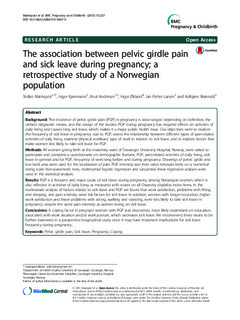| dc.description | This article was originally published in BMC Pregnancy and Childbirth. It is distributed under the terms of the Creative Commons Attribution 4.0
International License (http://creativecommons.org/licenses/by/4.0/), which permits unrestricted use, distribution, and
reproduction in any medium, provided you give appropriate credit to the original author(s) and the source, provide a link to
the Creative Commons license, and indicate if changes were made. | nb_NO |
| dc.description.abstract | Background: The incidence of pelvic girdle pain (PGP) in pregnancy is wide ranged depending on definition, the
utilised diagnostic means, and the design of the studies. PGP during pregnancy has negative effects on activities of
daily living and causes long sick leave, which makes it a major public health issue. Our objectives were to explore
the frequency of sick leave in pregnancy due to PGP, assess the relationship between different types of pain-related
activities of daily living, examine physical workload, type of work in relation to sick leave, and to explore factors that
make women less likely to take sick leave for PGP.
Methods: All women giving birth at the maternity ward of Stavanger University Hospital, Norway, were asked to
participate and complete a questionnaire on demographic features, PGP, pain-related activities of daily living, sick
leave in general and for PGP, frequency of exercising before and during pregnancy. Drawings of pelvic girdle and
low back area were used for the localization of pain. PGP intensity was then rated retrospectively on a numerical
rating scale. Non-parametric tests, multinomial logistic regression and sequential linear regression analysis were
used in the statistical analysis.
Results: PGP is a frequent and major cause of sick leave during pregnancy among Norwegian women, which is
also reflected in activities of daily living as measured with scores on all Oswestry disability index items. In the
multivariate analysis of factors related to sick leave and PGP we found that work satisfaction, problems with lifting
and sleeping, and pain intensity were risk factors for sick leave. In addition, women with longer education, higher
work satisfaction and fewer problems with sitting, walking and standing, were less likely to take sick leave in
pregnancy, despite the same pain intensity as women being on sick leave.
Conclusions: A coping factor in pregnant women with PGP was discovered, most likely dependant on education,
associated with work situation and/or work posture, which decreases sick leave. We recommend these issues to be
further examined in a prospective longitudinal study since it may have important implications for sick leave
frequency during pregnancy. | nb_NO |

